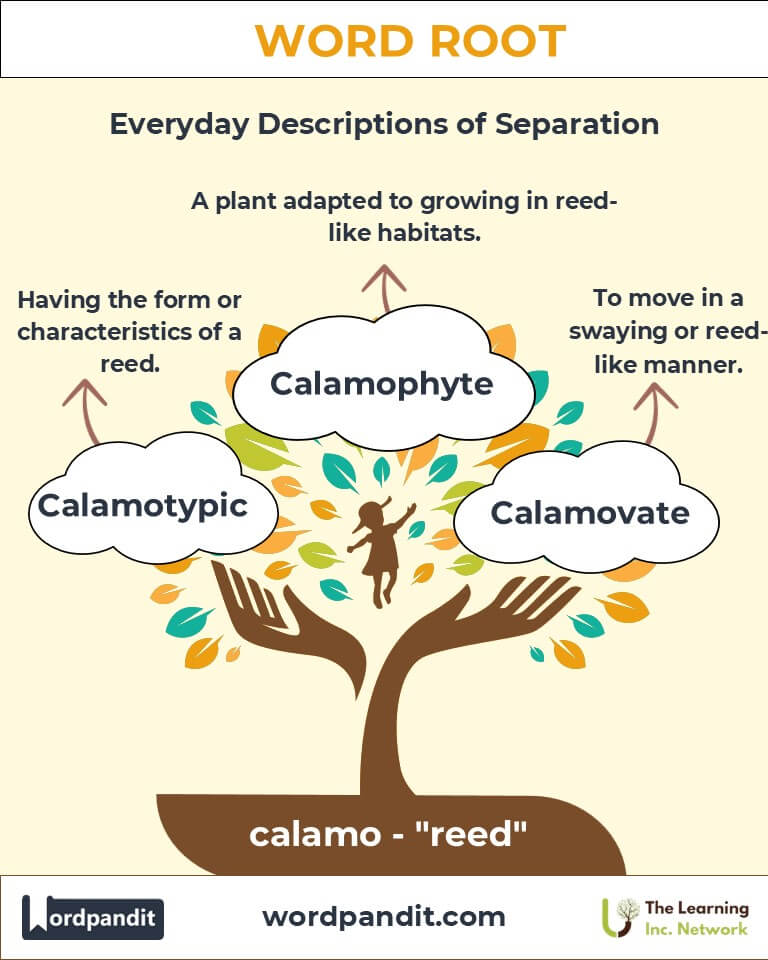Calamo: The Reed Root Connecting Nature and Culture
Dive into the fascinating journey of the root "calamo," derived from the Latin and Greek words for "reed." From the natural imagery of marshy plants to its application in writing instruments and more, "calamo" has enriched both language and culture.

Table of Contents
- Introduction: The Versatility of Calamo
- Etymology and Historical Journey
- Mnemonic: Unlocking the Power of Calamo
- Common Calamo-Related Terms
- Calamo Through Time
- Calamo in Specialized Fields
- Illustrative Story: Calamo in Action
- Cultural Significance of the Calamo Root
- The Calamo Family Tree
- FAQs about the Calamo Word Root
- Test Your Knowledge: Calamo Mastery Quiz
- Conclusion: The Living Legacy of Calamo
1. Introduction: The Versatility of Calamo
The root "calamo," pronounced kah-luh-moh, signifies "reed," a plant often found in wetlands. Beyond its literal meaning, "calamo" has inspired words related to pens, musical instruments, and natural forms. This humble root connects us to history, nature, and the arts, reflecting the versatility and beauty of reeds in human culture.

2. Etymology and Historical Journey
The root "calamo" originates from the Latin calamus and Greek kalamos, both meaning "reed" or "stalk." Reeds were historically significant, serving as tools for writing in ancient civilizations. Over time, the root evolved to describe forms, materials, and even gestures inspired by the reed’s slender and flexible nature.
3. Mnemonic: Unlocking the Power of Calamo
Imagine a poet sitting by a tranquil marsh, crafting words with a reed-pen while the gentle rustling of reeds provides inspiration.
Mnemonic Device: "Calamo connects reeds to creativity, from marshy fields to elegant scripts."
4. Common Calamo-Related Terms
- Calamus (KAL-uh-mus): A reed or reed-like structure.
Example: "The calamus plant thrives in the wetlands, waving gracefully in the breeze." - Calamiform (KAL-uh-muh-form): Shaped like a reed.
Example: "The calamiform architecture gave the columns a natural and slender appearance." - Calamity (kuh-LAM-ih-tee): Though metaphorical, this word’s association with destructive forces mirrors the reed's fragility.
Example: "The storm brought calamity to the small village." - Calamus Scriptorius (KAL-uh-muhs skrip-TOR-ee-uhs): A term for a writing tool made from reed.
Example: "Scribes of ancient Egypt used the calamus scriptorius for penning manuscripts."
5. Calamo Through Time
From the early Egyptian use of reeds as writing tools to their symbolic representation of flexibility in literature, the root "calamo" has undergone significant evolution:
- Early Use: Reeds were instrumental in crafting quills and musical pipes.
- Medieval Era: The term expanded to describe artistic forms inspired by the reed’s slender shape.
- Modern Usage: "Calamiform" and related terms appear in botany and art, symbolizing elegance and precision.
6. Calamo in Specialized Fields
- Botany:
- Calamus: Refers to specific reed plants, highlighting their ecological importance.
- Use Case: Vital in wetland conservation studies.
- Linguistics and Calligraphy:
Calamus Scriptorius: Reflects the historical role of reeds in writing and communication. - Art and Design:
Calamiform Designs: Frequently used in architecture and interior design for naturalistic aesthetics.
7. Illustrative Story: Calamo in Action
In an ancient scriptorium, a young monk named Arlen discovered the beauty of reeds while crafting manuscripts. He learned to use the calamus scriptorius to bring his calligraphy to life, the ink flowing seamlessly like water through a reed. His work inspired countless others, showing how the simplest tools, like a reed, could create timeless art.
8. Cultural Significance of the Calamo Root
Reeds have long been associated with adaptability and creativity. In many cultures, reeds symbolize resilience, swaying but never breaking in the wind. Their role in crafting musical instruments, pens, and even shelter underscores their practical and symbolic value in human history.

9. The Calamo Family Tree
- Cane (Latin: "reed, stalk"):
Examples: Candy cane, sugarcane. - Reed (Old English: "slender plant"):
Examples: Reed bed, reed flute. - Papyrus (Greek: "plant for writing"):
Examples: Papyrus manuscripts, papyrology.
10.FAQs About the Calamo Word Root
Q: What does "calamo" mean?
A: "Calamo" means "reed," referring to slender, hollow, and flexible plants commonly found in wetlands. These plants have had historical significance in writing, music, and art.
Q: What is a calamus?
A: A calamus is a type of reed-like plant often associated with wetlands. It also refers to a writing tool made from a reed, used in ancient and medieval times for crafting manuscripts.
Q: How were reeds historically significant?
A: Reeds played a vital role in early civilizations. They were used to craft pens for writing, pipes for music, and even as metaphors for flexibility and resilience in literature.
Q: What does "calamiform" mean?
A: "Calamiform" describes something shaped like a reed—thin, elongated, and cylindrical. This term is often used in botany or design to depict naturalistic or artistic forms.
Q: Why is the calamus important in calligraphy?
A: The calamus was one of the earliest tools used for writing. Ancient scribes shaped reeds into pens to create precise and elegant scripts on materials like papyrus and parchment.
11.Test Your Knowledge: Calamo Word Root Quiz
1. What does "calamo" signify?
2. What is "calamus" primarily associated with?
3. Which term means "shaped like a reed"?
4. How were reeds used in ancient times?
5. What does "Calamity" metaphorically reflect?

12. Conclusion: The Living Legacy of Calamo
The root "calamo" illustrates the enduring relationship between nature and human innovation. From reeds in ancient marshes to their presence in modern art and language, this root serves as a testament to the power of simplicity and creativity. As we continue to explore the world, may the humble reed inspire flexibility, elegance, and resilience in all aspects of life.











